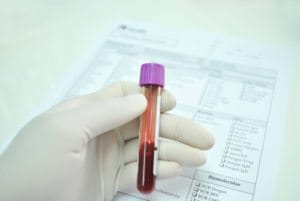The outlook for effective food allergy testing is growing brighter. New York researchers have discovered that a form of blood test called the Basophil Activation Test (or BAT) has the potential to predict how severe an individual’s reactions to a specific food allergen would be.
In their study, Mount Sinai researchers took blood samples from 67 patients between the ages of 12 and 45. The samples were then subjected to the BAT process, which tallies the number of basophils, a type of immune cell, that respond when blood is exposed to a food allergen.
The participants also underwent oral challenges (in which the person eats a food to test for symptoms). They were given either small amounts of common allergens to consume – peanut, tree nut, fish, shellfish, or sesame – or a placebo. Significantly, the study revealed that basophil activation results bore a close correlation with the severity of reactions in the oral food challenges.
If further study backs these findings, this approach would signal a major evolution in the ability to diagnose allergy severity. Study author Dr. Xiu-Min Li, a researcher in both The Mindich Child Health and Development Institute and the Jaffe Food Allergy at Mount Sinai, where the research was conducted, also noted that BAT could be useful in allergy screening in general. “It seems at least for the most persistent food allergies, this is an additional tool to help for the diagnosis process,” she told Allergic Living.
Typically, food allergies are diagnosed through a combination of skin-prick tests, blood tests that measure levels of IgE allergy antibodies, and the patient’s history of symptoms. None of the current tests, however, indicates whether the allergen will simply set off uncomfortable symptoms such as itchy hives, or whether it could send the patient into life-threatening anaphylaxis.
While an oral food challenge is a far more accurate test, the process itself can prompt a severe reaction. “Having blood drawn for BAT is a much less difficult procedure than food challenges,” says Dr. Ying Song, one of the study’s authors. “Although food challenges are widely practiced, they carry the risk of severe allergic reactions, and we hope that BAT can be developed further to provide accurate information in a safe manner,” she said.
Mount Sinai is not alone in making advances on the allergy testing front with its study (which was published online on April 1, 2015 in The Annals of Allergy, Asthma & Immunology).
Stanford University’s Dr. Kari Nadeau and her team are developing two blood tests, one of which appears to gauge both an allergy and severity, while the other identifies genes that have a role in suppressing the allergic response in food allergy.
Researchers at the University of Connecticut are also investigating blood test with similar predictive capabilities specifically for peanut allergy. The test, developed by three chemists, observes if a patient’s blood reacts to specific allergenic parts of peanut proteins and how intense the reaction is based blood antibody levels.
However, these blood tests are still at the experimental stages. Li cautions that the BAT process requires further refining, so it may take a few years before such tests to reach the allergist’s office.
“Although the blood basophil activation test has been shown to be an important addition to the tools available for discriminating between allergic and non-allergic individuals and predicting the severity of food allergy reactions, at this time it is only approved for research purposes,” she said.
In the future, Li says this type of testing could be applied to other food allergies and possibly even drug or insect allergies. However, she does not think that BAT will completely replace the current tests. Rather, “it’s an additional tool to existing practice,” she says.






